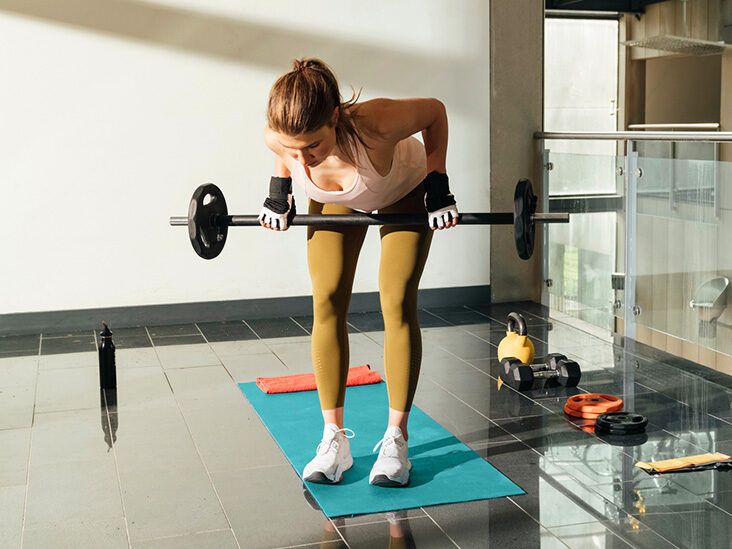You might be skipping one of the best exercises for it. The bent-over barbell row is a game changer. It builds thickness, strength, and that wide back look most people want. But here’s the truth. Most people mess it up. They use their arms too much or bounce the bar like it’s a dance move. If you’ve been there, don’t worry. You’re not alone.
Let’s break it all down and learn how to do it the right way. No fluff. No confusing gym lingo. Just clear tips and steps that actually help.
Why the bent-over barbell row is so good for your body
This move is more than a back exercise. It trains a bunch of muscles in one go. It hits your lats, rhomboids, traps, and rear shoulders. Even your lower back and core help keep you stable. It’s almost like a deadlift’s little cousin.
And let’s not forget your arms. Your biceps and forearms get stronger just from holding and pulling the bar. So if you want a back that looks powerful and a grip that won’t quit, the barbell row is your best friend.
Don’t rush it: Set your form before touching the bar
Before we even grab the barbell, we need to talk posture. If your setup is off, the whole thing falls apart. Think of your body like a crane. If the base isn’t solid, the arm can’t lift anything properly.
Here’s how to get into position:
- Stand with your feet about shoulder-width apart.
- Keep your knees soft. Don’t lock them.
- Push your hips back like you’re about to sit in a chair.
- Keep your chest up and your spine straight.
- Your back should be flat, not rounded.
- Your upper body should be bent over at about a 45-degree angle.
This part is huge. Most people bend too far or not enough. If your back rounds, you’re risking injury. If you’re too upright, you’re turning it into something else.
How to grip the bar for the strongest pull
Now that you’re in position, let’s grab the bar. Grip matters more than you think.
Use an overhand grip. Your palms should face you. Hands should be slightly wider than shoulder-width. Some people go too wide. That makes it harder to control the bar.
Keep your wrists straight. Don’t let them bend backward. Bent wrists lead to weak pulls and sore joints.
Your arms should hang straight down. The bar should be just in front of your knees. That’s your starting point.
Ready to row? Here’s the movement step-by-step
Now the fun begins. Time to row. But slow down. This isn’t about yanking the bar as hard as you can.
- Brace your core. Tighten your stomach like someone’s about to punch it.
- Pull the bar toward your lower chest or upper stomach. Aim for the area just below your sternum.
- Squeeze your shoulder blades together at the top.
- Don’t let your elbows flare out. Keep them close to your body.
- Lower the bar slowly back to the start. No dropping.
That’s one rep. Repeat for 8 to 12 reps if you want muscle growth. Go heavier with fewer reps if you want strength.
Keep your back still while pulling
This is where most lifters mess up. They rock their upper body to cheat the weight up. That’s not a bent-over row. That’s a hip thrust.
The goal is to keep your torso in the same position. Don’t jerk the weight. Don’t use momentum. Your back stays locked in. Only your arms and shoulder blades should move.
If the weight is too heavy to control, it’s too heavy for you. There’s no shame in dropping the weight a little. You’ll still grow, and you’ll protect your spine.
Why your bar path makes a difference
The path of the bar is important. If you pull it too high toward your neck, you’re turning it into an upright row. That targets your traps and shoulders more than your back.
If you pull too low toward your belly button, you shift the work to your arms and lose tension in your lats.
The sweet spot is the upper stomach. Keep the bar close to your body. Drag it up like you’re trying to shave your torso with it.
Your breathing pattern can help or hurt your reps
Most people forget to breathe properly. They hold their breath and turn red. That’s not the goal.
Here’s the right way:
- Inhale before you pull.
- Exhale as you pull the bar up.
- Inhale again as you lower the bar.
This keeps your core tight and helps with balance. It also prevents dizziness when lifting heavy.
How often should you do bent-over rows?
If you train your back once or twice a week, you can include barbell rows in each session. But don’t do it back-to-back days. Your muscles need time to recover.
One day, you can go heavy with lower reps. On another day, use lighter weight and focus on strict form. That combo builds strength and size without burning you out.
Want to switch things up? Try these row variations
Bored with the basic version? Or maybe you don’t have a barbell? No problem. There are tons of variations that keep the benefits going.
- Underhand Barbell Row
Your palms face up. This hits the lower lats more. It also brings your biceps into the game more. - Pendlay Row
This starts from the ground each rep. You pull fast and reset every time. It’s stricter and more explosive. - Dumbbell Row
Do it one arm at a time. This helps fix muscle imbalances and gives you a better range of motion. - T-Bar Row
Your body stays in the same position, but you use a landmine setup. It hits the middle of your back hard.
Try one of these if you want variety or if barbell rows hurt your lower back.
Small mistakes that kill your gains
It’s easy to make small mistakes that ruin the movement. Here are the most common ones to watch out for.
- Using momentum. If you’re bouncing, you’re not rowing.
- Standing too upright. That turns it into a shrug.
- Letting your elbows flare. That hurts your shoulders.
- Rounding your back. That can cause injuries fast.
- Pulling with your arms only. The goal is back activation.
Record yourself if needed. Sometimes you think your form is good, but the video says otherwise.
Your back should feel sore, not your lower spine
The bent-over row will work your lower back a little. That’s normal. It helps keep you stable. But if your lower back feels more tired than your upper back, something’s wrong.
Your posture might be off. Or the weight might be too heavy. Or you’re rowing with your spine instead of your arms. Make small changes and try again.
How to progress and keep getting stronger
Don’t add weight too fast. Focus on perfect form first. Once your form is locked in, you can add small plates each week.
Try to increase reps or weight every 1 to 2 weeks. Track your progress. Write down your sets, reps, and how the weight felt.
Use straps if your grip is the weak point. That way, your back still gets the full workout. But don’t rely on them every time. Build that grip strength too.
Stretch after to avoid tightness
Your back and hamstrings can get tight after rowing. Do a quick stretch session afterward. It keeps your muscles loose and helps with recovery.
A few good ones include:
- Cat-cow stretch
- Child’s pose
- Standing forward fold
- Doorway lat stretch
Hold each one for 20 to 30 seconds. Your body will thank you later.
Final tip: Don’t be afraid to ask for feedback
If you train at a gym, ask a coach to check your form. One small fix can save you from months of bad habits. If you’re at home, record your form from the side and watch it back.
Mastering the bent-over barbell row takes time. But once you do, your back strength and size will shoot up. Just keep showing up. One row at a time.










